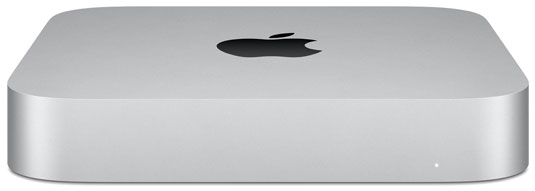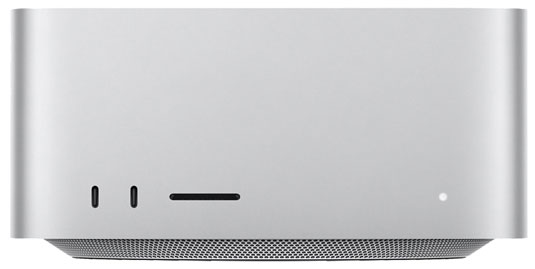Hosted by site sponsor WebMate.
Mac Studio Q&A
Revision Published July 5, 2023
All Mac Q&As >> Mac Studio Q&A (Home)
To be notified of new Q&As, sign up for EveryMac.com's bimonthly email list.
What are the main differences between the original Mac Studio (2022) and the Mac mini available at the time the Mac Studio was released?
These Mac Studio and Mac mini models have been discontinued. However, this Q&A has been updated subsequently and can be quite helpful for anyone considering either model on the used market.
As organized by EveryMac.com, there is a single "2020 M1" Mac mini -- the Mac mini "M1" 8-Core 3.2 (2020) -- and two stock 2022 Mac Studio models -- the Mac Studio "M1 Max" 10 CPU/24 GPU and Mac Studio "M1 Ultra" 20 CPU/48 GPU.
This Q&A mostly compares collective differences to help you decide whether the more affordable, less capable Mac mini or more expensive, higher performance Mac Studio is best for your needs.
External Differences
The Mac mini and Mac Studio both use compact "cuboid" aluminum cases that are 7.7 inches across and deep, but the Mac mini only is 1.4 inches tall whereas the Mac Studio is 3.7 inches tall.

Photo Credit: Apple, Inc. (Mac mini - Front)
It is unlikely to matter much for a desktop system, but the Mac Studio also is much heavier than the Mac mini. The Mac mini is only 2.6 lbs. (1.2 kg) whereas the Mac Studio models are either 5.9 lbs. (2.7 kg) or 7.9 lbs. (3.6 kg).

Photo Credit: Apple, Inc. (Mac Studio - Front)
Connectivity Differences
Connectivity is a substantial point of differentiation between the "2020 M1" Mac mini and the "2022" Mac Studio models.
The Mac mini has entirely rear-mounted ports. It includes two USB-A ports, two "Thunderbolt / USB 4" (USB-C) ports that support Thunderbolt 3, an HDMI 2.0 port, a 3.5 mm headphone jack, default Gigabit Ethernet (10-Gigabit Ethernet available as a custom configuration), Bluetooth 5.0, and 802.11ax (Wi-Fi 6).
The Mac Studio models, on the other hand have front and rear-mounted ports. All models include two USB-A ports, four Thunderbolt 4 ports (USB-C shaped connector), an HDMI port, a 10-Gigabit Ethernet port, and a 3.5 mm headphone jack on the back. They also support Bluetooth 5.0 and 802.11ax (Wi-Fi 6).
On the front, all Mac Studio models include an SDXC (UHS-II) card slot, but the entry-level Mac Studio M1 Max has two USB-C ports (up to 10 Gb/s) whereas the higher-end Mac Studio M1 Ultra has two much faster Thunderbolt 4 ports (up to 40 Gb/s).
The Mac mini supports "up to" two simultaneous displays -- one "up to" 6K resolution (6016x3384) at 60 Hz via Thunderbolt 3 and one display "up to" 4K (4096x2160) at 60 Hz via HDMI 2.0. The Mac Studio, by contrast, supports "up to" five simultaneous displays -- four displays "up to" 6K resolution (6016x3384) at 60 Hz via USB-C and one display "up to" 4K (4096x2160) at 60 Hz via HDMI.
Identification Differences
At least when they are sitting side-by-side, there is no reason to confuse the Mac mini and Mac Studio. However, it is easy to mix up the "2020 M1" Mac mini with any number of other models, and it is useful to be able to reference the Model Numbers and EMC Numbers on the hardware itself as well as the Model Identifiers in software.
EveryMac.com diligently has hand documented these identifiers for decades. The Model Identifier in software likely will be the most reliable way to spot these specific models in the long-term:
| Mac Model | Model No. | EMC No. | Model ID |
| mini 2020 M1 | A2348 | 3569 | Macmini9,1 |
| Studio M1 Max | A2615 | 3988 | Mac13,1 |
| Studio M1 Ultra | A2615 | 3988 | Mac13,2 |
More information about specific identifiers is provided in EveryMac.com's extensive Mac Identification section.
Internal Differences
Internally, the "2020 M1" Mac mini and "2022" Mac Studio models have little in common. They use different processors, graphics, storage, and more. Unfortunately, both lines have memory that is onboard and that cannot be upgraded after purchase at all. The Mac mini has its storage soldered onboard, as well. The Mac Studio, on the other hand, has its storage on one or two removable modules, but these are not intended to be upgraded, either.
The "2020 M1" Mac mini models, use Apple's M1 architecture with an 8-Core CPU, an 8-Core GPU and "unified" RAM. By default, the "2020 M1" Mac mini ships with 8 GB of RAM and 256 or 512 GB or storage, but its RAM can be upgraded to 16 GB and its storage to 1 TB or 2 TB at the time of purchase. It cannot be upgraded at all after the initial system purchase.
The "2022" Mac Studio models, by contrast, use more powerful M1 Max or M1 Ultra architectures with 10-Core or 20-Core CPUs, GPUs ranging from 24-Cores to 64-Cores, and a default 32 GB or 64 GB of "unified" RAM. At the time of initial system purchase, the Mac Studio can be upgraded to as much as 128 GB of RAM and 8 TB of storage.
Comparison Chart
The specific differences between processors, architectures, configurations, connectivity, upgrades, identifiers, and prices for the standard "2020 M1" Mac mini and "2022" Mac Studio are summarized below:
 "2020 M1" Mac mini |
 "2022" Mac Studio |
|
|---|---|---|
| Std. Processors: | Apple M1 | Apple M1 Max/Ultra |
| CPU Cores: | 8 | 10-20 |
| GPU Cores: | 8 | 24-64 |
| Std. RAM: | 8 GB | 32, 64 GB |
| Max. RAM: | 16 GB† | 64, 128 GB† |
| RAM Upgrades: | No (Unified)† | No (Unified)† |
| Std. Storage: | 256, 512 GB | 512 GB, 1 TB |
| Dual Displays: | 4K & 6K | 4K x1; 6K x4 |
| eGPU Support: | No | No |
| Security Chip: | Unified | Unified |
| Wi-Fi: | 802.11ax | 802.11ax |
| Thunderbolt: | 2 Ports | 4, 6 Ports |
| SD Card Slot: | No | Yes |
| Gigabit Ethernet: | Yes (10 Gigabit Opt) | Yes (10 Gigabit Std) |
| Case Color: | Silver | Silver |
| Order Number: | MGNR3LL/A MGNT3LL/A |
MJMV3LL/A MJMW3LL/A |
| EMC Number: | 3569 | 3988 |
| Model Identifier: | Macmini9,1 | Mac13,1, Mac13,2 |
| Intro Price (US): | US$699, US$899 | US$1999, US$3999 |
| Intro Price (UK): | £699, £899 | £1999, £3999 |
| Intro Price (CA): | C$899, C$1149 | C$2499, C$4999 |
| Intro Price (AU): | A$1099, A$1399 | A$3099, A$6099 |
| Intro Price (SG): | S$979, S$1279 | S$2899, S$5899 |
† The RAM in the "2020 M1" Mac mini models can be upgraded to 16 GB, the Mac Studio M1 Max can be upgraded to 64 GB, and the Mac Studio M1 Ultra can be upgraded to 128 GB. The RAM cannot be upgraded after purchase in any of these models.
For pricing information in dozens of other countries, refer to EveryMac.com's Global Original Prices section.
So, is a Mac mini or Mac Studio best for my needs?
The Mac Studio clearly is the more capable system. Compared to the Mac mini M1, the Mac Studio (1) is much faster running high-end, multicore-capable software for video editing, music production, and scientific modeling, for example, but it is only 4% faster in single core tasks. The Mac Studio also has (2) more RAM, (3) the option of more storage, (4) more extensive connectivity, (5) much more significant external display support, and (5) a convenient SD card slot.
Although the value proposition may have changed somewhat on the used market, when both were new, even the entry-level Mac Studio cost at least 122% more than the Mac mini (US$1999 rather than US$899 or US$1100 more), which is a substantial difference. For those who do not use high-end software or who do not need the extra connectivity or use more than two displays, the Mac mini, comparatively, is quite the bargain.
New & Used Mac mini & Mac Studio Purchase Options
There are a wide variety of places to buy a used or new Mac mini or Mac Studio. However, purchasing from a well regarded seller with a solid track record in the Mac market will provide the best experience and save you money and time, too.
In the US, site sponsor Other World Computing sells used and refurb Mac Studio models at bargain prices with free shipping. If you need to sell a Mac Studio or just about any other recent Mac, A+ BBB-rated Cash for Your Mac will buy your older Mac with an instant quote and prompt payment.
In the UK, site sponsor Hoxton Macs sells used Mac Studio models with a one-year warranty and free next working day delivery throughout the UK.
Please refer to EveryMac.com's Ultimate Mac Comparison feature to dynamically compare any Mac mini or Mac Studio to any other Mac.
Permalink | Report an Error/Typo | Sign Up for Site Update Notices
Suggest a New Q&A | Sign Up for Bimonthly Site Update Notices
<< Mac Studio Q&A (Main) | All Mac Q&As
Established in 1996, EveryMac.com has been created by experts with decades of experience with Apple hardware. EveryMac.com includes, and always has included, original research incorporating detailed, hands-on inspection of packaging, computers, and devices as well as extensive real-world use. All information is provided in good faith, but no website or person is perfect. Accordingly, EveryMac.com is provided "as is" without warranty of any kind whatsoever. EveryMac.com, and the authors thereof, shall not be held responsible or liable, under any circumstances, for any damages resulting from the use or inability to use the information within. For complete disclaimer and copyright information please read and understand the Terms of Use and the Privacy Policy before using EveryMac.com. Copying, scraping, or use of any content without expressed permission is not allowed, although links to any page are welcomed and appreciated.
